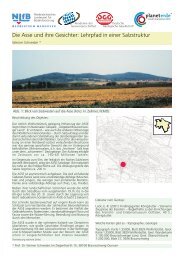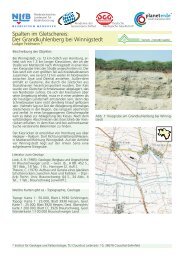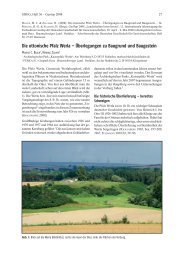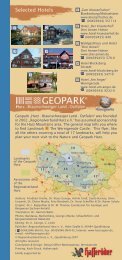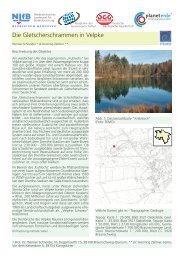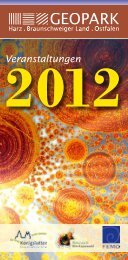Geopark LM 3 Englisch 2007.indd - Geopark Harz
Geopark LM 3 Englisch 2007.indd - Geopark Harz
Geopark LM 3 Englisch 2007.indd - Geopark Harz
You also want an ePaper? Increase the reach of your titles
YUMPU automatically turns print PDFs into web optimized ePapers that Google loves.
World Cultural Heritage I<br />
Rammelsberg Goslar<br />
1<br />
In contrast to the Upper <strong>Harz</strong> ore deposits,<br />
the Rammelsberg ore was formed on<br />
the ocean-floor together with the surrounding<br />
sediments. The orebodies lie overturned,<br />
that is to say “upside down” - a<br />
result of the folding of the <strong>Harz</strong> Mountains.<br />
The ores are rich in lead, zinc and copper<br />
as well as other elements, among which<br />
are cadmium, gold and silver. For the In the Rathstiefste Gallery<br />
mine owners of the past, the foremost<br />
interest was obtaining copper and silver,<br />
and later lead; modern mining concentrated<br />
on obtaining zinc and barite.<br />
The Old Orebody was probably discovered<br />
as early as the Bronze Age. Later- in<br />
the middle ages and early modern times<br />
– it provided the wealth of the German<br />
kings, the Dukes of Brunswick and the<br />
City of Goslar. During the high middle Rammelsberg banded ore<br />
ages the major emphasis was on argentine<br />
copper ore - so abundant that the<br />
Ottonian and Salian emperors built the<br />
largest of all their palatinates at the foot<br />
of the Rammelsberg. Commerce in metals<br />
secured the merchants of Goslar influence<br />
in the Hanseatic League. During the<br />
second period of prosperity in the<br />
Rammelsberg in the 16th century, however,<br />
the rights to the mines were taken by<br />
Geology tour<br />
the Dukes of Brunswick - to the detriment of the Goslar mine<br />
owners, but not to the detriment of mining.<br />
A final period of prosperity occurred in Rammelsberg mining<br />
in the 20th century, after optimal separation of the finely<br />
intergrown ore had been achieved. In 1988 the deposit was<br />
exhausted; mining and ore dressing operations were shut<br />
down. The Rammelsberg was the only ore mine works in the<br />
world which had been in continual operation for over 1000<br />
years. In 1992, together with the Old Town of Goslar, it was<br />
entered on the UNESCO World Cultural Heritage List.<br />
When visiting the WELTKULTURERBE RAMMELSBERG one<br />
encounters important mining monuments everywhere: mine<br />
dumps from the 10th century, the Rathstiefste Gallery (12 th<br />
c.), the Feuergezäher Vault (the oldest masonry-constructed<br />
underground mine room in Europe), the Maltermeister Tower<br />
(the oldest above ground structure of German mining), the<br />
Roeder Gallery (19th c.) with its water wheels, and many<br />
others. In four museum buildings permanent as well as changing<br />
exhibits covering the life and work of man, modern art<br />
- which open baffling approaches to the local work culture -<br />
as well as geology and mineralogy are presented.<br />
www.rammelsberg.de<br />
+49 53 21-75 00<br />
for English tours advance booking is required<br />
Open daily<br />
9:00 a.m – 6:00 p.m.<br />
(except Dec. 24. and 31.)



